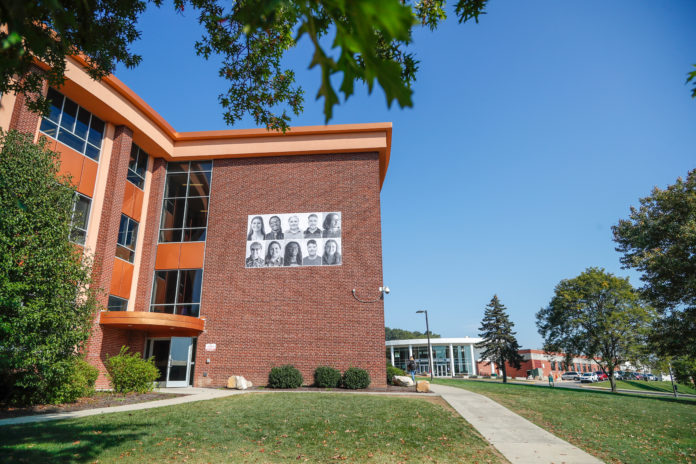
Along with 128 other countries, the United States – specifically Slippery Rock, Pennsylvania – took part in Inside Out: The People’s Art Project, adapting the theme “Face Diversity, Foster Inclusion.”
The participatory, collaborative art project initiated in 2011 and has since expanded to 129 countries and over 1,300 group actions.
The idea started when an artist began taking portraits of community members in small towns and put them on silos, the sides of industrial buildings and trains.
Doctor Cindy LaCom, a gender studies professor, was excited to bring this installation to Slippery Rock, beginning the conversation with Theresa Antonellis from the art department and Usruala Payne with the Frederick Douglas Institute in February of 2019.
“I think this is going to be one of the coolest [projects],” LaCom said. “It’s innovative and interesting. If you [put a picture] on a giant boulder next to the ocean, we can’t match that on our campus, but in terms of scope, breadth and visual power, I think it’s fascinating and as inspiring as any [installation].”
The People’s Art Project is hosted by the art department, the Frederick Douglas Institute and the gender studies program, with co-sponsorship by the President’s Commision for Gender Identity and Expression and Sexual Orientation (GIESO) and Residence Life.
The 5’x3’ portraits are hung on the side of buildings and the portraits around SRU are part of the 260,000 portraits worldwide.
The preparation for this project began with seven photo booths set up over a three week period where students volunteered to get their picture taken.
Along with volunteers, LaCom and Antonellis reached out to about 25 different student organizations, offices, resident life and GIESO.
Currently, 180 portrait photographs have been taken of SRU students and the community, a curtsey of Jamie Hunt’s photography class.
LaCom said that they are deeply commited to the practice of diversity and believes that this project starts to emphasize the diversity and inclusion on campus.
“Diversity by itself is never enough,” LaCom said. “If you’re not practicing inclusion, then you can still be a diverse place and have people feel discriminated against and not included.”
LaCom adopted a mantra around diversity and inclusion after talking to an international student who said they would have felt more at home on campus if they had seen a picture of someone like them in their first year.
Although LaCom said that those involved with the project were also careful not to misrepresent the diversity on campus.
“I feel that it’s important to be accurate, but also to have a visual reminder that says we do have diversity here and this is a way to be inclusive,” LaCom said.
Responses to the installation have been mainly positive, LaCom said. They mentioned one run in with a student outside of Vincent when the potraits were being hung up.
“We had a guy come up and stop in his tracks,” LaCom said. “He said ‘Oh my God, this is the third time I’ve walked by and have been so buried in my phone that I never even looked up. What is this? This is cool.”
Although, LaCom also said that they had a talk with a student with a more conservative idealogy than themself, who said that it was weird that pictures of students were on the outside of buildings, wondering why they were staring at him.
“I hope people are visually reminded that there is an incredible array of difference and that difference is beautiful,” LaCom said.
The conversation won’t stop when the installations are finished. In the future there will be an exhibit in the Martha Art Gault Art Gallery about Inside Out: The People’s Art Project, “Face Diversity, Foster Inclusion.”
However, LaCom said that they hope the conversation extends into residence halls, the Smith Student Center, parties on Friday night and between families.
“We get so attuned to the notion that learning happens in classrooms,” LaCom said. “Some of the most important lessons I’ve learned have nothing to do with the classroom. I think what this project invites is a reminder that learning happens everywhere.”
LaCom believes that artistic movements can drive social change in ways that academics can’t.
“I love that this isn’t prescriptive,” LaCom said. “It doesn’t say, this is what we want you to think. It invites conversations and it invites people to look and relook.”
LaCom said that the timing of the installation was not random. Those helping with the project wanted to wait to start hanging flyers and go live with everything.
“To have people ask ‘what is this?’, it’s such an awesome question,” LaCom said.







